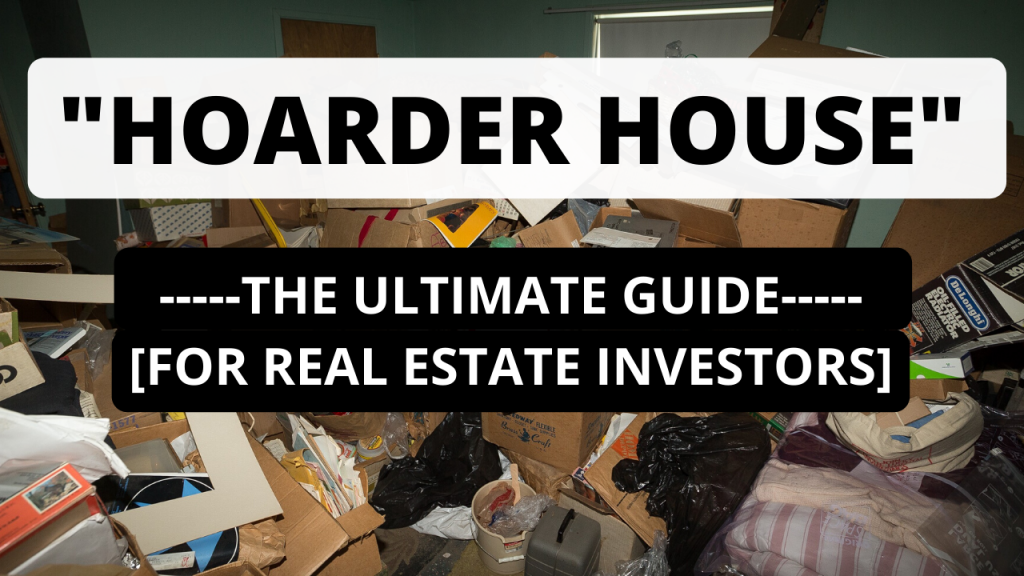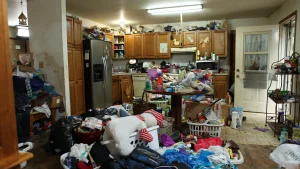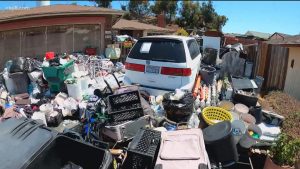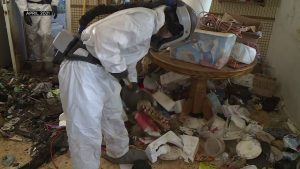What is a Hoarder House ? Things You Must Know in 2022

Have you ever wondered what a “hoarded house” was all about? A hoarder house is a residence that has been overrun by a tenant’s or owner’s excessive personal belongings.
A single-family home, condo, townhouse, or apartment can all suffer from hoarding.
People with hoarding disease suffer from a mental illness that makes them amass excessive amounts of clutter and trash. The subject has gained so much interest that Hoarders, a hit television series, has been created.
It is quite difficult for a hoarder to let go of anything. While you have a hoarding disorder, you experience severe stress when considering parting with any possessions, regardless of their value.
When hoarding gets out of control, it can cause serious health issues and social isolation.
A house that has descended into disarray due to the owners’ accumulation of an excessive amount of disorganised objects, the majority of which are worthless, is frequently referred to as a hoarders’ house.
With a hoarder, almost everything has sentimental worth. Let’s examine hoarder homes in detail and learn everything there is to know about them. If you would like to know more about hard rubbish collection check out WM Waste Management Services

What is a Hoarder?
A residence that has been excessively stuffed with personal belongings by the owner or tenant is known as a hoarder house.
Hoarders hold on to everything. Food, magazines, newspapers, furniture, clothing, cartons, and other trinkets may be gathered by a hoarder.
There is typically only a little passageway through the rooms of a hoarder’s home because it is so cluttered and filthy.
Desks, sinks, stoves, countertops, and stairways are frequently littered with an inconceivable number of items.
A hoarder may continue to spread out into other areas of the property, such as the garage, storage sheds, and yard, if there is no longer enough room inside the house.
Anything is persistently difficult to get rid of. With a hoarder, almost everything has sentimental worth.
Hoarding is a mental condition that requires medical attention. Obsessive-compulsive disorder may coexist with hoarding disorder in some people (OCD).
Hoarding disorders are thought to affect two to six percent of the population. The first people to suspect a mental disease that would likely require professional assistance are frequently family members.

Hoarder Houses Explained
A residence that has descended into chaos due to the occupants’ accumulation of an excessive amount of disorganized personal goods, the majority of which have no real value, is referred to as a “hoarder house.” There may frequently only be a footpath through many of the rooms in these homes because of the amount of clutter they hold.
In hoarder homes, space is limited and most surfaces, including counters, tables, stairs, and floors, are covered with clutter. The oven and sinks are similarly cluttered, making it impossible to utilize them for their intended purpose. When a hoarder’s home is overstuffed, the owner’s belongings may even overflow into the front and back yards, garage, storage shed, and automobiles.
Dangerous Living Conditions are Produced in Hoarders’ House
Hoarders frequently reside in hazardous homes, which causes health issues for both the hoarders and the people who live there.
Firefighters frequently encourage people to keep flammable items outside of their homes. It wouldn’t be odd for a hoarder to store gasoline or combustible items about their home. Hoarders frequently have homes that are fire dangers.
If doors and windows are blocked or people inside are likely to trip, the clutter in the house may make it more difficult to flee.
In addition, rodents, flies, and cockroaches are drawn to hoarding-related homes, especially if there is decaying food and human waste present.
Hoarder House Creates Health Problems
For its occupants, a hoarder house may produce hazardous living circumstances. The home is filled with stacks of combustible materials, which increases the likelihood that a fire will spread quickly if it does. If the entrances and exits are obstructed by the excessive clutter or if individuals inside are prone to trip when rushing out of the house, it may also be more difficult to leave the house.
Hoarder homes frequently have unhealthy living conditions for the residents. Basic housekeeping tasks are challenging for hoarder house dwellers to complete because of the clutter. Hoarder homes are notorious for having a lot of dust, a lot of waste, and mold and mildew growing in the bathrooms and kitchens. The entire house can be filled with strong smells. Pet dander, urine, and excrement may be found in the living areas of a hoarder house if there are animals there.
Breathing contaminated air is common in many hoarder homes, which over time can cause respiratory issues and a general deterioration in human and animal health. The bacteria E. coli and Staph, especially MRSA, are other potential biohazards.
There may be unusable toilets in severe hoarder households where home maintenance has been neglected, lice on bedding, rats chewing through electrical lines, decaying food, flea and rodent infestation, and human feces on the floors and walls. Sometimes, dead pets are not removed from the house, which makes the sanitation issue worse.
Hoarder homes can be dangerous to the nearby homes since any combustibles left in the yard can start a fire that spreads to those residences.
In hoarding situations, rodents, flies, and cockroaches are also drawn, especially if there is decaying food and human waste present inside the home and nearby.
A hoarder not only suffers from a mental disease, but their condition may also worsen existing medical conditions.
Hoarder homes’ unsanitary interiors contribute to the bad health of many residents. Residents of a hoarder residence find it difficult to clean because of the clutter.
Some hoarders reside in homes with a reputation for having an abundance of dust and waste, as well as mold and mildew growth in the kitchen and bathroom.
Visitors to a hoarder residence with pets could discover unhygienic conditions including pet hair, urine, and even feces all over the place. Often, the smell is intolerable.
Many occupants of hoarder homes are breathing air that is tainted with dangerous substances, which can eventually cause respiratory issues and a decline in their health.
Unusable toilets can be caused by objects that have fallen into them, lice on bedding, chewed-through electrical cables from rodents, decaying food, and flea and rodent infestation in hoarder houses when routine home maintenance has halted.
Hoarders Who Have Died in a House
Living in a hoarded home might be fatal if conditions deteriorate to that point. It does not sound good.
Here are several ways to check to see if someone died in a hoarder house before you buy it. Although that is a disturbing thought, it does occur.
Hoarders frequently experience a wide range of health issues as a result of their surroundings.

There Are Five Levels Of Hoarding in a House
Five hoarding severity levels, ranging from minor to severe, have been charted by the Institute of Challenging Disorganization.
Level One Hoarder House
A level one hoarder dwelling has minimal to no scents and only a modest quantity of clutter.
Level One Hoarder House
Level two hoarders have begun to gather trash that is beginning to obstruct living spaces and emits obnoxious scents. There is frequently pet waste on the floor as well as rat droppings.
Level Three Hoarder House
One bedroom and one bathroom that have gathered so much clutter as to be unusable are typical of a level three hoarder. Countertops with garbage bins are common. Cans for garbage are filled.
Level Four Hoarder House
In addition to all of the aforementioned hoarding observed in levels one through three, a level four hoarder residence will also have an abundance of vermin, animal sanitation issues, and decaying food. There are potent smells that could make you queasy. Hoarding of animals also occurs occasionally.
Level Five Hoarder House
The worst type of hoarding is a level five hoarder residence. The majority of the doors and windows are obstructed by debris.
Unfathomable amounts of clutter lead to harmful environments. Each resident of the house frequently has health issues.
What Are The Symptoms of a Hoarding Disorder? Hoarding disorder symptoms
There are early indicators for those who end up with a hoarded home.
A mental health disease known as hoarding disorder is defined by an excessive accumulation of stuff, which makes it difficult to get rid of things and causes living environments to become cluttered. It often appears in adolescence or the early years of adulthood.
As a person becomes older, they frequently begin to accumulate things for which there is no urgent need or need.
In middle age, symptoms can become severe and difficult to manage.
Hoarding issues typically arise over time and are a private behavior. By the time relatives and friends become aware of the clutter, it has typically accumulated significantly.
What Causes House Hoarding Disorder?
Extreme feelings of not wanting to throw anything away are the beginning of hoarding problems. Those who are affected start to think that their possessions are special and will be valuable in the future.
Frequently, the objects can stand in for something special or happier times. They feel safer and more wanted as they amass more possessions.
There may be a family history of hoarding individuals. It’s likely that the hoarder’s mentality was brought on by a significant life tragedy, such a death.
Additionally, depression and obsessive-compulsive personality disorder are linked to hoarding. Studies exploring the potential reasons of hoarding, including genetics, brain function, and stressful life experiences, are being done.
Being a collector is totally different from being a hoarder of things in your home. People who are interested in collecting comic books, stamps, coins, or other such goods do so.
These relics don’t contribute to a messy or unclean situation on a property.

What Are The Downsides of a Hoarders House?
When a person develops hoarding tendencies, their life may turn into a never-ending struggle with mess. Because hoarding makes it difficult to purchase basic products, this frequently results in financial trouble.
Due to the possibility of losing their homes if they are forcibly removed from their homes or condemned, people with hoarding disorders may endure strained relationships.
Because of the chaotic and overwhelming environment they live in, children of hoarders may develop depression or another mental illness.
A hoarding parent may cause some adolescent or teen to shy away from hosting friends or family members at their home.
Children may be removed from the house to avoid health risks, while others may resent their parents for the unhealthy lifestyle the hoarding generates.
The market value of a hoarded home may likewise suffer significantly. Even modestly cluttered homes will sell for less money than turnkey homes.
Due to the terrible circumstances, fixer-upper homes are frequently referred to as hoarder houses.
How is a Housing Hoarding Problem Treated?
As previously said, a hoarder house is a sign of a mental disease that requires treatment from a physician or other health professional experienced in treating such conditions.
Hoarding is diagnosed by a qualified mental health practitioner. An expert in diagnosis could be a clinical social worker, psychiatrist, counselor, or psychologist.
When hoarding is discovered, it is crucial to get the hoarder help. According to the American Psychiatric Association, cognitive behavioral therapy is frequently used to treat hoarding problems (CBT).
Health organizations that deal with hoarding issues exist in some localities. To assist in resolving this issue, local or county government resources might be available.
You might need to get in touch with the local authorities if your loved one’s hoarding disorder is putting their health or safety in jeopardy.
Notifying the police, fire department, child or elder protective services, or animal welfare organizations may be necessary in certain serious situations. They can assist anyone residing with a hoarder as well.
Can a Hoarder House Be Condemned?
If the situation became bad enough, a municipal board of health might declare a property condemned. It is more likely if there is trash, rubbish, and other material in someone’s yard that is affecting neighbors.
With this much hoarding, a person can be considered a horrible neighbor. Action can be done when the situation becomes severe enough to lower local property values.
Who Purchases Hoarder Houses?
The measures to clean up a hoarder’s home as outlined above may not always be possible. In situations like these, the buyer pool is significantly less when a property is sold “as-is.”
It frequently results in a cash sale from a contractor or real estate investor. Companies like We Buy Ugly Houses search for damaged homes like hoarder residences to buy. They’ll provide a cash deal and move rapidly to close.
A lot of these we buy houses for cash businesses would be thrilled to acquire a hoarder’s residence.
These businesses will patch up the properties they buy at a discount. They will undergo a thorough renovation before being sold for a profit.
Selling to an investor is not the best course of action when trying to maximize your profits. If you do your homework, you’ll discover that when these properties are left in their hoarded state, they sell for far less.
Even if you are not an investor, you might require funding for a rehab loan to purchase one of these properties. Given the anticipated bad condition, an FHA 203k loan would be an excellent financing alternative.
What’s the Best Way to Find a Hoarders House Near Me?
Are there any neighboring hoarders’ homes to be found? Yes, but it’s not particularly simple.
Try searching for a hoarder’s house nearby or a hoarder house for sale on Google if you are a contractor or are in the home-flipping business. Google may recognise MLS descriptions of such homes from well-known real estate websites.
You may also attempt to get around on your own, but that would be considerably harder. Unkempt homes, an abundance of trash, a backlog of mail, blocked windows, and a lot of accumulated debris in the yard are a few traits to watch out for.
Final Words on Hoarder House
Hoarding is a significant issue that needs to be addressed. When symptoms first develop, mental health illnesses should be addressed as a problem. Try to get them some aid if you have a friend or relative who keeps items in their home.







